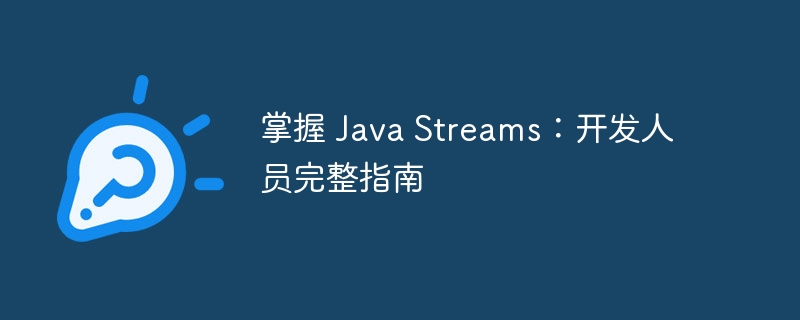掌握 Java Streams:开发人员完整指南

java streams 在 java 8 中引入,是该语言最强大的补充之一。它们支持对集合和序列进行函数式操作,改变了我们在 java 中处理数据的方式。流简化了过滤、映射和收集数据等任务,同时还支持并行操作以提高性能。在这篇文章中,我们将探讨 streams 的基础知识,讨论它们支持的操作类型,并提供示例来帮助您充分利用这一基本功能。
目录
1. what is streams and why we need it? 2. types of streams: intermediate vs. terminal 3. creating streams in java 4. intermediate stream operations 5. terminal stream operations 6. using streams with lambdas 7. conclusion
什么是 streams 以及为什么我们需要它?
java 中的流提供了一种处理数据集合的强大方法。它们允许我们对集合的元素执行功能操作,例如过滤和转换,而无需改变底层数据。流帮助开发人员专注于他们想要实现的目标,而不是如何实现它,为数据处理提供了更高级别的抽象。
java 8 中引入了流以及 lambda 表达式和函数式接口,旨在使 java 更具表现力并减少样板代码。通过合并流,java 开始拥抱函数式编程范式,允许更干净、更简洁的代码。
流的主要优点
- 声明式数据处理:描述您想要执行的操作,而不是手动管理循环和条件。
- 不变性和无状态性:流操作不会修改源数据结构。
- 并行处理:支持并行流,允许轻松地将操作分布在多个线程上。
流类型:中间流与终端流
流分为两种主要类型:
- 中间操作:这些操作转换流,并返回另一个流作为结果。它们是惰性的——这意味着它们在调用终端操作之前不会执行。
- 终端操作:这些操作触发流的数据处理并返回非流结果(例如,集合、单个值或布尔值)。一旦执行了终端操作,流就被视为已消耗并且不能被重用。
示例:
list<string> names = list.of("alice", "bob", "charlie", "david");
// intermediate (lazy) operations: filter and map
stream<string> stream = names.stream()
.filter(name -> name.startswith("a"))
.map(string::touppercase);
// terminal operation: collect
list<string> filterednames = stream.collect(collectors.tolist());
system.out.println(filterednames); // output: [alice]
在这个例子中,filter和map是中间操作,直到调用终端操作collect后才会执行。
在 java 中创建流
java 提供了多种创建流的方法,可以轻松开始处理数据。
- 来自收藏
创建流的最常见方法是使用 list、set 和 map 等集合。
list<string> names = list.of("alice", "bob", "charlie");
stream<string> namestream = names.stream();
- 来自数组
string[] namesarray = {"alice", "bob", "charlie"};
stream<string> namestream = arrays.stream(namesarray);
- 使用 stream.of
stream<string> stream = stream.of("alice", "bob", "charlie");
- 无限流(生成流)
java 允许使用 stream.generate 和 stream.iterate 创建无限流。
stream<double> randomnumbers = stream.generate(math::random).limit(5); stream<integer> counting = stream.iterate(0, n -> n + 1).limit(5);
中间流操作
中间操作返回一个新流并且是惰性的。这意味着它们仅在调用终端操作时执行。
- 过滤器(谓词
)
根据条件过滤元素。
list<integer> numbers = list.of(1, 2, 3, 4, 5);
list<integer> evennumbers = numbers.stream()
.filter(n -> n % 2 == 0)
.collect(collectors.tolist());
- 地图(function
)
将元素从一种类型转换为另一种类型。
list<string> names = list.of("alice", "bob");
list<integer> namelengths = names.stream()
.map(string::length)
.collect(collectors.tolist());
- 排序(比较器
)
按自然顺序或基于比较器对元素进行排序。
list<string> names = list.of("bob", "alice", "charlie");
list<string> sortednames = names.stream()
.sorted()
.collect(collectors.tolist());
- 查看(consumer
)
对每个元素执行操作,通常对于调试很有用。
list<string> names = list.of("alice", "bob");
names.stream()
.peek(name -> system.out.println("processing " + name))
.collect(collectors.tolist());
终端流操作
最后执行终端操作,触发实际的数据处理并返回最终结果。
- foreach(consumer
)
对流中的每个元素执行一个操作。
list<string> names = list.of("alice", "bob");
names.stream().foreach(system.out::println);
- 收集(收藏家)
将流的元素收集到集合、列表、集合或其他数据结构中。
list<string> names = list.of("alice", "bob");
set<string> nameset = names.stream().collect(collectors.toset());
- 计数()
计算流中元素的数量。
list<string> names = list.of("alice", "bob");
long count = names.stream().count();
-
anymatch(predicate
), allmatch(predicate ), nonematch(predicate )
检查是否有任何、全部或没有元素符合给定条件。
list<string> names = list.of("alice", "bob", "charlie");
boolean hasalice = names.stream().anymatch(name -> name.equals("alice"));
- findfirst() 和 findany()
返回一个可选描述流的第一个或任何元素。
list<string> names = list.of("alice", "bob");
optional<string> first = names.stream().findfirst();
将流与 lambda 结合使用
流和 lambda 表达式齐头并进。由于流基于函数式接口,因此它们可以与 lambda 无缝协作,从而实现富有表现力且简洁的数据处理。
例如,过滤名称列表以查找以“a”开头的名称,然后将其转换为大写:
List<String> names = List.of("Alice", "Bob", "Alex", "David");
List<String> result = names.stream()
.filter(name -> name.startsWith("A"))
.map(String::toUpperCase)
.collect(Collectors.toList());
System.out.println(result); // Output: [ALICE, ALEX]
在此示例中:
结论
java streams 为 java 带来了函数式编程功能,允许进行富有表现力和简洁的数据操作。通过了解中间操作和终端操作之间的区别以及如何有效地创建和使用流,您可以显着增强代码的可读性和可维护性。将流和 lambda 集成到您的工作流程中,以编写更干净、更高效的 java 应用程序。
祝直播愉快!
以上就是掌握 Java Streams:开发人员完整指南的详细内容,更多请关注其它相关文章!
